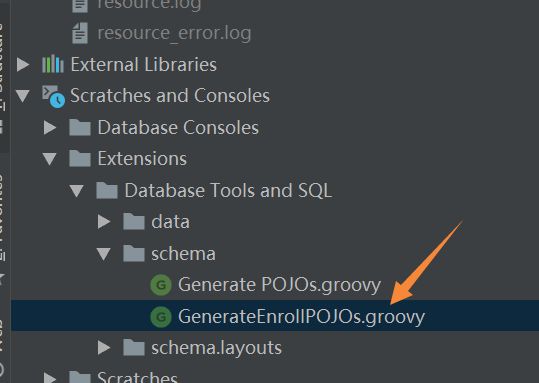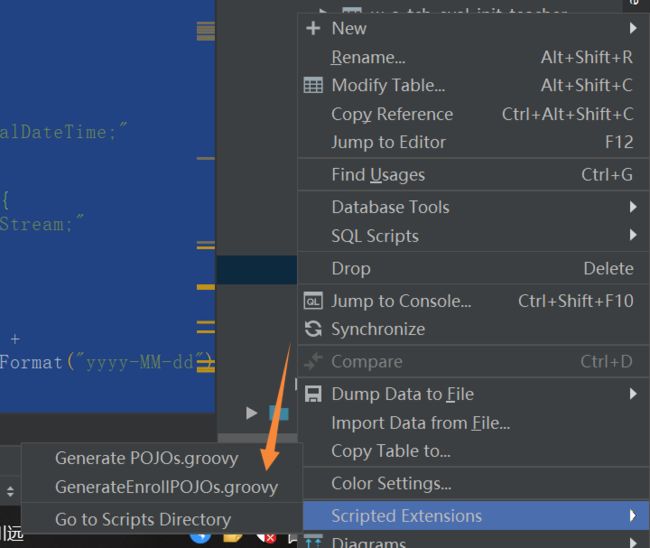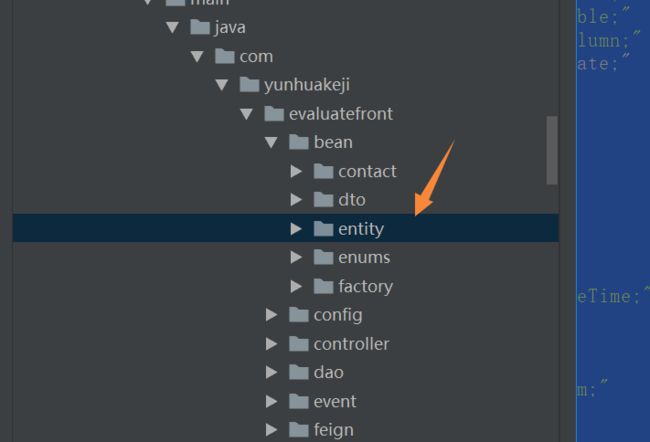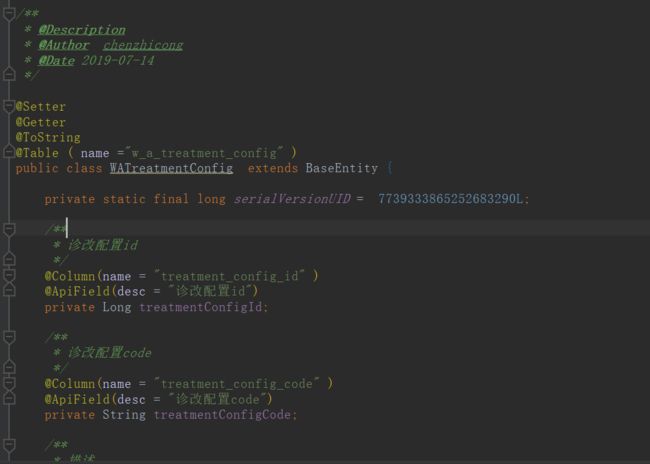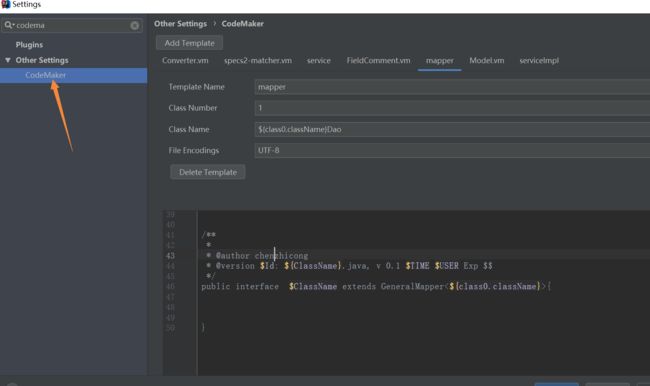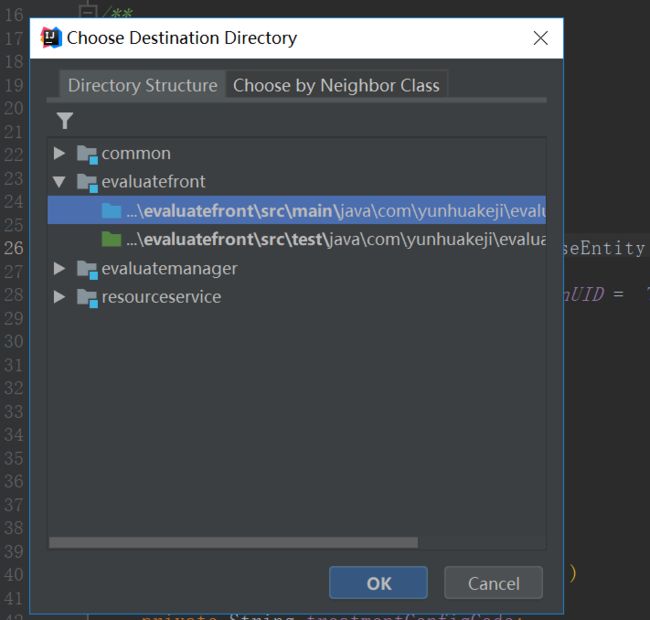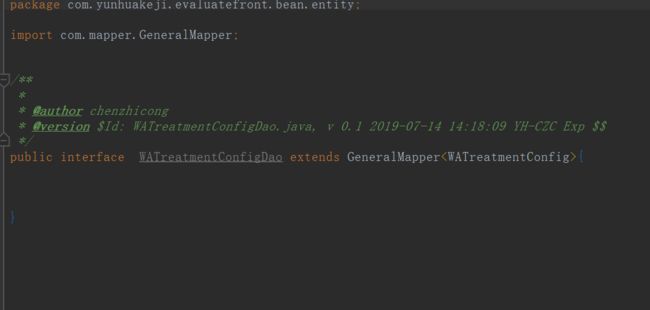经常写一些业务代码,学会快速生成项目上业务代码所需的类entity、dao、service类对我们提高工作效率很有帮助,整理步骤如下:
一、准备工作
- 在idea中连接数据库
- 下载idea的CodeMaker插件
二、生成实体类
准备生成实体类的groovy脚本,这里我直接用写好了的脚本,因为不懂groovy,只能是在脚本上猜着改改,但实体类生成都差不多,猜着改改勉强能改到满足自己要求,下面把脚本贴上:
import com.intellij.database.model.DasTable
import com.intellij.database.model.ObjectKind
import com.intellij.database.util.Case
import com.intellij.database.util.DasUtil
import java.io.*
import java.text.SimpleDateFormat
import java.lang.*;
/*
* Available context bindings:
* SELECTION Iterable
* PROJECT project
* FILES files helper
*/
packageName = ""
typeMapping = [
(~/(?i)bigint/) : "Long",
(~/(?i)int|tinyint|smallint|mediumint/) : "Integer",
(~/(?i)bool|bit/) : "Boolean",
(~/(?i)float|double|decimal|real/) : "Double",
(~/(?i)datetime|timestamp|date|time/) : "Date",
(~/(?i)blob|binary|bfile|clob|raw|image/): "InputStream",
(~/(?i)/) : "String"
]
FILES.chooseDirectoryAndSave("Choose directory", "Choose where to store generated files") { dir ->
SELECTION.filter { it instanceof DasTable && it.getKind() == ObjectKind.TABLE }.each { generate(it, dir) }
}
def generate(table, dir) {
def className = javaName(table.getName(), true)
def fields = calcFields(table)
packageName = getPackageName(dir)
PrintWriter printWriter = new PrintWriter(new OutputStreamWriter(new FileOutputStream(new File(dir, className + ".java")), "UTF-8"))
printWriter.withPrintWriter {out -> generate(out, className, fields,table)}
// new File(dir, className + ".java").withPrintWriter { out -> generate(out, className, fields,table) }
}
// 获取包所在文件夹路径
def getPackageName(dir) {
return dir.toString().replaceAll("\\\\", ".").replaceAll("/", ".").replaceAll("^.*src(\\.main\\.java\\.)?", "") + ";"
}
def generate(out, className, fields,table) {
out.println "package $packageName"
out.println ""
out.println "import com.yunhuakeji.component.base.annotation.doc.ApiField;"
out.println "import com.yunhuakeji.component.base.annotation.entity.Code;"
out.println "import com.yunhuakeji.component.base.bean.entity.base.BaseEntity;"
out.println "import com.yunhuakeji.component.base.enums.entity.YesNoCodeEnum;"
out.println "import lombok.Getter;"
out.println "import lombok.Setter;"
out.println "import lombok.ToString;"
out.println "import io.swagger.annotations.ApiModel;"
out.println "import io.swagger.annotations.ApiModelProperty;"
out.println "import java.time.LocalDateTime;"
out.println "import javax.persistence.Table;"
out.println "import javax.persistence.Column;"
//out.println "import import java.util.Date;"
Set types = new HashSet()
fields.each() {
types.add(it.type)
}
if (types.contains("Date")) {
out.println "import java.time.LocalDateTime;"
}
if (types.contains("InputStream")) {
out.println "import java.io.InputStream;"
}
out.println ""
out.println "/**\n" +
" * @Description \n" +
" * @Author chenzhicong\n" +
" * @Date "+ new SimpleDateFormat("yyyy-MM-dd").format(new Date()) + " \n" +
" */"
out.println ""
out.println "@Setter"
out.println "@Getter"
out.println "@ToString"
out.println "@Table ( name =\""+table.getName() +"\" )"
out.println "public class $className extends BaseEntity {"
out.println ""
out.println genSerialID()
fields.each() {
if(!"universityId".equals(it.name)&&
!"operatorId".equals(it.name)&&
!"createdDate".equals(it.name)&&
!"state".equals(it.name)&&
!"stateDate".equals(it.name)&&
!"memo".equals(it.name)){
out.println ""
// 输出注释
if (isNotEmpty(it.commoent)) {
out.println "\t/**"
out.println "\t * ${it.commoent.toString()}"
out.println "\t */"
}
if (it.annos != "") out.println " ${it.annos.replace("[@Id]", "")}"
// 输出成员变量
out.println "\tprivate ${it.type} ${it.name};"
}
}
// 输出get/set方法
// fields.each() {
// out.println ""
// out.println "\tpublic ${it.type} get${it.name.capitalize()}() {"
// out.println "\t\treturn this.${it.name};"
// out.println "\t}"
// out.println ""
//
// out.println "\tpublic void set${it.name.capitalize()}(${it.type} ${it.name}) {"
// out.println "\t\tthis.${it.name} = ${it.name};"
// out.println "\t}"
// }
out.println ""
out.println "}"
}
def calcFields(table) {
DasUtil.getColumns(table).reduce([]) { fields, col ->
def spec = Case.LOWER.apply(col.getDataType().getSpecification())
def typeStr = typeMapping.find { p, t -> p.matcher(spec).find() }.value
if("Date".equals(typeStr)){
typeStr="LocalDateTime"
}
if(col.getName().toString().startsWith("PK_")){
typeStr = "Long"
}
def comm =[
colName : col.getName(),
name : javaName(col.getName(), false),
type : typeStr,
commoent: col.getComment(),
annos: "\t@Column(name = \""+col.getName()+"\" )"]
if(isNotEmpty(col.getComment())){
comm.annos +="\r\n\t@ApiField(desc = \""+col.getComment()+"\")"
}
/* if(col.getComment().startsWith("pk_")){
comm.annos +="\r\n\t@Id"
}*/
if(Case.LOWER.apply(comm.name.toString()).startsWith("pk")){
comm.annos +="\r\n\t@Id"
}
if("id".equals(Case.LOWER.apply(col.getName()))){
comm.annos +=["@Id"]}
fields += [comm]
}
}
// 处理类名(这里是因为我的表都是以t_命名的,所以需要处理去掉生成类名时的开头的T,
// 如果你不需要那么请查找用到了 javaClassName这个方法的地方修改为 javaName 即可)
def javaClassName(str, capitalize) {
def s = com.intellij.psi.codeStyle.NameUtil.splitNameIntoWords(str)
.collect { Case.LOWER.apply(it).capitalize() }
.join("")
.replaceAll(/[^\p{javaJavaIdentifierPart}[_]]/, "_")
// 去除开头的T http://developer.51cto.com/art/200906/129168.htm
s = s[1..s.size()-1]
capitalize || s.length() == 1? s : Case.LOWER.apply(s[0]) + s[1..-1]
}
def javaName(str, capitalize) {
// def s = str.split(/(?<=[^\p{IsLetter}])/).collect { Case.LOWER.apply(it).capitalize() }
// .join("").replaceAll(/[^\p{javaJavaIdentifierPart}]/, "_")
// capitalize || s.length() == 1? s : Case.LOWER.apply(s[0]) + s[1..-1]
def s = com.intellij.psi.codeStyle.NameUtil.splitNameIntoWords(str)
.collect { Case.LOWER.apply(it).capitalize() }
.join("")
.replaceAll(/[^\p{javaJavaIdentifierPart}[_]]/, "_")
capitalize || s.length() == 1? s : Case.LOWER.apply(s[0]) + s[1..-1]
}
def isNotEmpty(content) {
return content != null && content.toString().trim().length() > 0
}
static String changeStyle(String str, boolean toCamel){
if(!str || str.size() <= 1)
return str
if(toCamel){
String r = str.toLowerCase().split('_').collect{cc -> Case.LOWER.apply(cc).capitalize()}.join('')
return r[0].toLowerCase() + r[1..-1]
}else{
str = str[0].toLowerCase() + str[1..-1]
return str.collect{cc -> ((char)cc).isUpperCase() ? '_' + cc.toLowerCase() : cc}.join('')
}
}
static String genSerialID()
{
return "\tprivate static final long serialVersionUID = "+Math.abs(new Random().nextLong())+"L;"
}
把脚本保存为groovy格式然后移动到项目目录中入图所示:
接下来就可以直接在idea右侧database中对需要生成实体类的表执行脚本了,如图所示,点击右侧的database-选择表右键-选择scripted-Extensions-然后选择添加的脚本
之后类就生成好了:
其中继承的类,引入的包,注解都可以在脚本中修改。
三、生成service、serviceImpL和dao
与实体生成不一样,这里使用codemaker插件功能生成。先在codemaker中添加模板。 进入settings,搜索codemaker,进入codemaker相关配置项。
添加所需要的模板,以生成Dao为例:上面只需要改className,这里写入${class0.className}Dao,表示取输入的类的类名后面加个Dao
模板代码也是使用现成的,自己根据需要猜着改就行,模板代码如下: dao/mapper模板:
########################################################################################
##
## Common variables:
## $YEAR - yyyy
## $TIME - yyyy-MM-dd HH:mm:ss
## $USER - 陈之聪
##
## Available variables:
## $class0 - the context class, alias: $class
## $class1 - the selected class, like $class1, $class2
## $ClassName - generate by the config of "Class Name", the generated class name
##
## Class Entry Structure:
## $class0.className - the class Name
## $class0.packageName - the packageName
## $class0.importList - the list of imported classes name
## $class0.fields - the list of the class fields
## - type: the field type
## - name: the field name
## - modifier: the field modifier, like "private",or "@Setter private" if include annotations
## $class0.allFields - the list of the class fields include all fields of superclass
## - type: the field type
## - name: the field name
## - modifier: the field modifier, like "private",or "@Setter private" if include annotations
## $class0.methods - the list of class methods
## - name: the method name
## - modifier: the method modifier, like "private static"
## - returnType: the method returnType
## - params: the method params, like "(String name)"
## $class0.allMethods - the list of class methods include all methods of superclass
## - name: the method name
## - modifier: the method modifier, like "private static"
## - returnType: the method returnType
## - params: the method params, like "(String name)"#
########################################################################################
package $class0.PackageName;
import com.mapper.GeneralMapper;
/**
*
* @author chenzhicong
* @version $Id: ${ClassName}.java, v 0.1 $TIME $USER Exp $$
*/
public interface $ClassName extends GeneralMapper<${class0.className}>{
}
service、serviceImpl操作方法类似,就不赘述了,按照上面的方法分别建立模板就行。
模板建立好了之后,我们就只需要在刚刚生成的实体类中按快捷键Alt+Insert(或者右键-Generate)-选择对应模板-然后选择生成目录:
这里好像只能生成在entity同目录,不能选择其他目录,需要我们移动到对应的包。 生成后的dao如图所示:
总结
至此,代码就生成完毕了,这个方法让自己初次接触到了groovy脚本,不过还是不会怎么用,不过凑合复制粘贴别人的脚本也能改改。先就这样吧,以后遇到相关该脚本的问题再百度。
